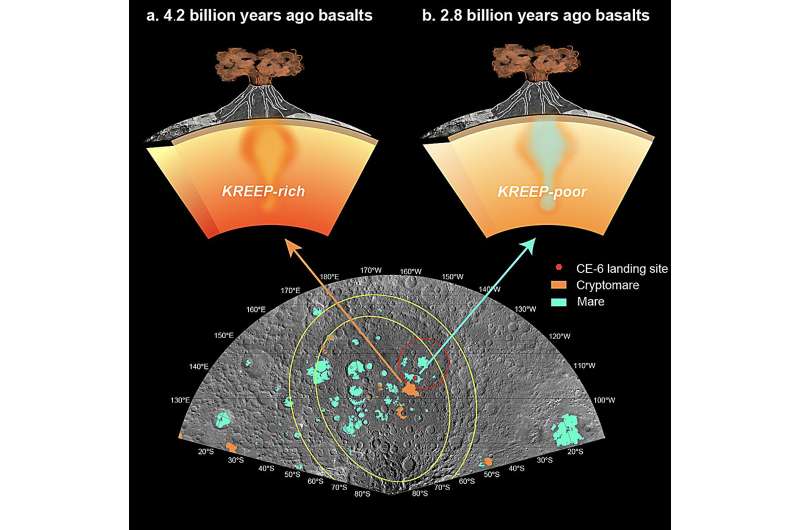Basalt samples returned by the Chang’e-6 mission have revealed volcanic events on the lunar farside at 2.8 billion years ago (Ga) and 4.2 Ga, according to research conducted by Prof. Li Qiuli’s lab at the Institute of Geology and Geophysics of the Chinese Academy of Sciences. Their work is published in Nature.
“Unraveling the volcanic history of the lunar farside is crucial for understanding the hemispheric dichotomy of the moon,” said Prof. Li.
The asymmetry between the moon’s nearside and farside—encompassing differences in basalt distribution, topography, crustal thickness, and thorium (Th) concentration—has long been a mystery. However, China’s Chang’e-6 mission—the first to return samples from the lunar farside—has created a unique opportunity to explore volcanic activity in this hemisphere, with the 1,935.3 g lunar soil sample it retrieved.
Led by Prof. Li, postdoctoral researcher Zhang Qian conducted systematic radioisotope dating on 108 basalt fragments from this sample. Of these, 107 fragments revealed a consistent formation age of 2,807 ± 3 million years ago (Ma), indicating the eruption age of local basalts at the Chang’e-6 landing site. Notably, this 2.8 Ga volcanic episode has not been observed in nearside samples.
The remaining fragment, of high-aluminum basalt and dating to 4,203 ± 4 Ma, is thought to have originated from a cryptomare region south of the landing site. It is the oldest lunar basalt sample yet returned whose age has been precisely determined.
These data indicate that volcanic activity on the lunar farside persisted for at least 1.4 billion years, from 4.2 Ga to 2.8 Ga. Initial lead isotope analysis suggests that these basalts derive from distinct mantle sources: The 4.2 Ga basalt came from a KREEP-rich source, i.e., one with abundant potassium (K), rare earth elements (REE), and phosphorous (P), while the 2.8 Ga basalt came from a KREEP-poor source.
The close alignment between the 2.8 Ga basalt age and crater-counting estimates suggests that the cratering chronology model, established based on nearside observations, is also applicable to the lunar farside. The radioisotope ages of the Chang’e-6 basalts provide an essential calibration point for refining lunar crater-counting chronology, thus enhancing its accuracy, according to Prof. Li.
More information:
Lunar farside volcanism 2.8 billion years ago from Chang’e-6 basalts, Nature (2024). DOI: 10.1038/s41586-024-08382-0
Provided by
Chinese Academy of Sciences
Citation:
Basalt samples from Chang’e-6 mission offer insights on lunar farside volcanism (2024, November 15)
retrieved 15 November 2024
from https://phys.org/news/2024-11-basalt-samples-mission-insights-lunar.html
This document is subject to copyright. Apart from any fair dealing for the purpose of private study or research, no
part may be reproduced without the written permission. The content is provided for information purposes only.

